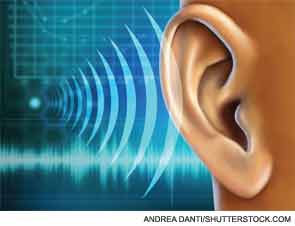Explore This Issue
January 2014
The treatment of single-sided deafness (SSD) has come a long way in the last decade, with wireless technology-enabled hearing aids and osseointegrated devices exemplifying only two of the many noteworthy advances. These newer treatment options have opened up a much wider base of patients with SSD who can benefit.
“The attitude used to be, sure, you’re deaf in one year, but you still have another functional ear. Deal with it—go off and live your life,” said David M. Baguley, MBA, PhD, head of service: audiology/hearing implants at Cambridge University Hospitals, in Cambridge, England. But such an attitude downplays the significant psychosocial handicap these patients struggle with daily, Dr. Baguley added (See “Psychosicial Aspects of SSD,” below). Given the sophistication and effectiveness of the newer SSD interventions, “there’s simply no need to let that continue; we can help patients find an effective intervention.”
One of the latest developments in the treatment of SSD is the SoundBite, from SonitusMedical, which employs a behind-the-ear (BTE) microphone unit worn on the patient’s deaf side. The BTE unit uses a digital signal processor and a wireless chip to transmit detectedsound to a custom-fit, in-the-mouth (ITM) device. Placed on either the left or right back molars, the ITM device converts the sound transmissions into vibratory energy, which then flows via bone conduction to the inner ear on the contralateral side.
Richard K. Gurgel, MD, assistant professor in the division of otolaryngology-head and neck surgery at the University of Utah Health Care in Salt Lake City, co-authored a recent study of the SoundBite (Laryngoscope. 2013;123:2807-2812). The study, which was funded by Sonitus Medical, followed 34 patients for six months and used validated self-assessment tests to measure patient satisfaction with the device. Results from the Abbreviated Profile of Hearing Aid Benefit patient questionnaire were particularly impressive, said Dr. Gurgel, who had no other funding or financial relationships with Sonitus Medical to disclose. “Each of the major subscores we looked at—ease of communication, background noise, reverberation, and global benefit—improved significantly when we compared them to baseline scores,” he said.
A related patient self-assessment test also yielded very favorable results. Longer-term follow-up data will be presented at the American Otological Society Annual Meeting this spring.
Dr. Gurgel did note some potential limitations, including the difficulty of eating with the device in place. But, he said most patients adapt either by getting used to the sensation or removing the device prior to eating, much like a dental retainer. Additionally, 12 patients reported acoustic feedback, “similar to when a hearing aid whistles,” he said. “But about half of those patients’ feedback resolved when we adjusted the device.”
Leave a Reply